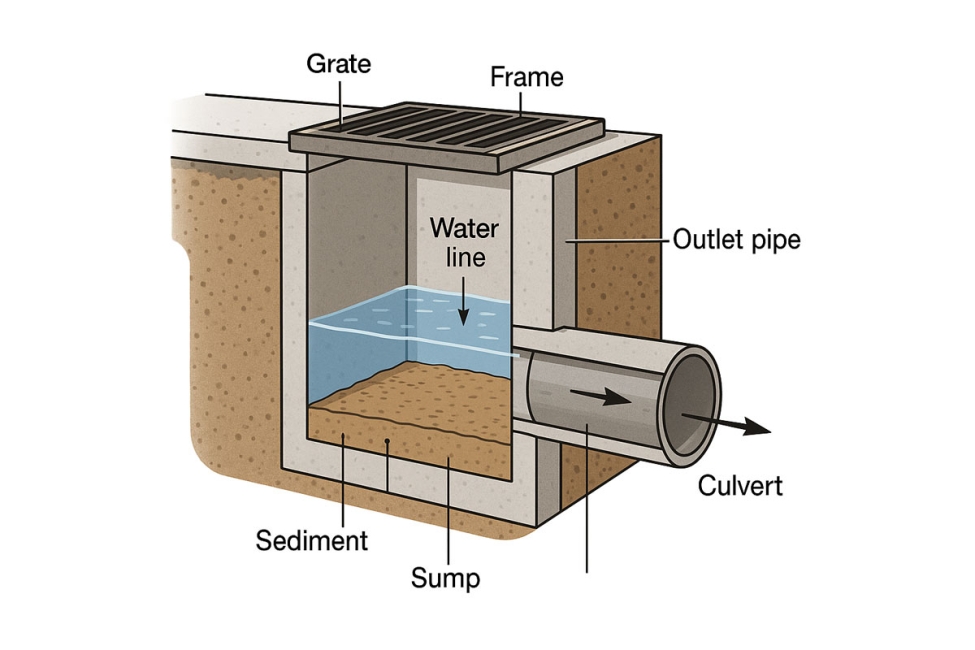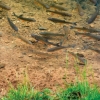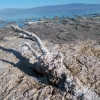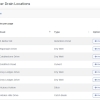
Every time rain falls on streets and parking lots, it sweeps grit, trash, and pollutants toward the nearest low point. Catch basins sit at those low points, quietly collecting runoff and helping cities keep roadways safe, pipes clear, and receiving waters cleaner. This article explains how catch basins work, why they matter in a municipal stormwater network, and what it takes to keep them operating effectively.
A catch basin is a below-grade structure, usually made of precast concrete, brick, or plastic, installed at the curb or in a parking lot. Its primary tasks are to:
Collect surface runoff that flows off paved areas.
Separate debris and sediment in a sump before water enters downstream pipes.
Provide access for inspection, cleaning, and connection to other drainage structures.
| Component | Purpose |
|---|---|
| Grate or Curb Inlet | Allows runoff to enter while keeping out large objects and providing some pedestrian safety. |
| Frame & Risers | Support the grate or inlet and set final elevation to match pavement. |
| Sump (Sedimentation Chamber) | A deeper section below the outlet where heavy grit and trash settle out of the water column. |
| Outlet Pipe | Carries partially-clarified water to the next storm sewer structure or directly to an outfall. |
| Trap or Hood (optional) | Prevents floating oils and debris from escaping when installed on the outlet pipe. |
Inflow: Rainwater and surface runoff enter through the grate or curb opening.
Energy Dissipation: The sudden drop into the basin reduces flow velocity, allowing heavier materials to settle.
Sediment Capture: Grit, sand, and debris collect in the sump, gradually building up.
Outflow: Cleaner water exits through the outlet pipe, often equipped with a trap that holds back floatables like oil or styrofoam.
Protecting Downstream Pipes: By removing grit and trash early, catch basins prevent sediment buildup that can clog pipes and reduce hydraulic capacity.
Reducing Flooding: Properly spaced basins limit the spread of surface water, lowering hydroplaning risk and protecting property.
Supporting Water Quality Goals: Although not as effective as engineered treatment devices, catch basins provide measurable reductions in total suspended solids (TSS) and floatables, helping meet MS4 permit targets.
Ease of Access: Maintenance crews can vacuum or dip debris out of a catch basin without excavating the road, making it a cost-effective control measure.
| Task | Frequency | Notes |
|---|---|---|
| Visual Inspection | Twice a year, before and after leaf season | Look for plugged grates, standing water, structural damage. |
| Sump Cleaning | When sediment reaches one-third of sump depth, or annually in high-load areas | Use vacuum truck or clamshell bucket. |
| Structural Repairs | As needed | Fix cracks, reset frames, and replace damaged grates to maintain capacity and safety. |
| Recordkeeping | Ongoing | Document dates, sediment volumes, and observations to demonstrate MS4 compliance. |
Clogged Grates: Leaves, litter, or snow can block inlets, causing localized flooding.
Undersized Sumps: Shallow basins fill quickly, reducing pollutant capture efficiency.
Illicit Connections: Sanitary or industrial discharges routed to a catch basin can send pollutants straight to waterways.
Freeze-Thaw Damage: Repeated cycles can crack walls and heave frames, creating trip hazards and compromising capacity.
Adequate Spacing: Position basins to limit gutter flow width and depth, usually every 100–300 ft, depending on slope and rainfall intensity.
Sump Depth: Provide at least 24 in of sump below the outlet pipe, or deeper in heavy sediment zones.
Oil-Droplet Controls: Add hoods or hydrodynamic separators where vehicle fluids are common.
Easily Accessible Locations: Avoid placing basins directly in wheel paths to simplify maintenance and reduce traffic disruption.
Marking and Mapping: Paint or stencil “Drains to Waterway” near inlets and keep basins mapped in a GIS for rapid inspection scheduling.
Catch basins may be simple boxes under the street, yet they perform critical work—capturing debris, reducing sediment loads, and protecting both infrastructure and waterways. When designed correctly and maintained on schedule, they extend the life of downstream pipes and help municipalities meet regulatory obligations at a relatively low cost. Keeping these unsung structures in top condition is one of the smartest investments a stormwater program can make.
 Wetlands are often described as the kidneys of the watershed because they filter, slow, and transform the water that passes through them in ways that …
Wetlands are often described as the kidneys of the watershed because they filter, slow, and transform the water that passes through them in ways that …
 Field inspections of catch basins, manholes, culverts, and outfalls form the foundation of responsible stormwater management. These routine checks giv…
Field inspections of catch basins, manholes, culverts, and outfalls form the foundation of responsible stormwater management. These routine checks giv…
 Habitat disruption around drainage structures is often subtle at first, and many of the earliest signs tend to appear during ordinary field work rathe…
Habitat disruption around drainage structures is often subtle at first, and many of the earliest signs tend to appear during ordinary field work rathe…
 Harmful algal blooms have become one of the most pressing water quality problems in many regions, and their rise has been linked to a complicated blen…
Harmful algal blooms have become one of the most pressing water quality problems in many regions, and their rise has been linked to a complicated blen…
 The Salton Sea is one of California’s most unusual and tragic landscapes, a place shaped by accident, transformed by ambition, and ultimately pu…
The Salton Sea is one of California’s most unusual and tragic landscapes, a place shaped by accident, transformed by ambition, and ultimately pu…
 *The screenshots used in this article are from Roadwurx, an asset management software created for road maintenance departments. Managing a town’…
*The screenshots used in this article are from Roadwurx, an asset management software created for road maintenance departments. Managing a town’…